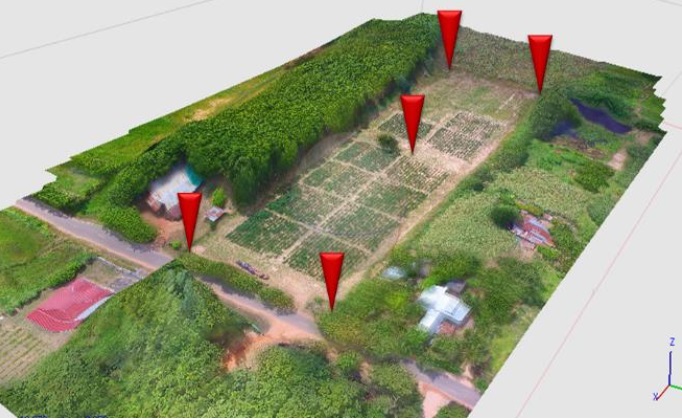An Evaluation of UAV-Derived Aerial Imagery for Estimating the Fresh ABG Biomass of Cassava
doi: 10.14456/mijet.2024.5
Keywords:
Biomass, UAV, Cassava, Allometric EquationAbstract
The objective of this study to estimate the above-ground biomass of cassava using aerial imagery-derived UAV. The cassava plantation aerial imagery by UAV with a 20M pixel camera was acquired by flying at an altitude of 30 meters and 90 meters to compare the ability to estimate the fresh ABG biomass of cassava. The data processing of UAV images was carried out using modern computer vision algorithms for estimating the geometric parameters of cassava to calculate the fresh above-ground biomass of cassava from the allometric equation derived from the measurement of height (H) and the fresh biomass above the ground of the cassava from the cassava plantation. The results showed that the flying altitudes of 30 meters and 90 meters of the accuracy achievement had RMSE values of 0.65 and 0.98 respectively. This study can be used as a guideline for estimating the fresh above ground biomass of cassava plantation with UAV photogrammetry.
References
U. Food and A. Organization, "Corporate Statistical Database (FAOSTAT)," Crops/Regions/World List/Production Quantity 2022.
U. Food and A. Organization, "Corporate Statistical Database (FAOSTAT)," Crops/Regions/World List/Production Quantity 2022.
Z. Zhang, K. Li, and J. Huang, "Development situation and strategy of cassava industry in China: Development revelation of cassava industry in Wuming of Guangxi," Guangxi Agricultural Science, vol. 37, no. 6, pp. 743-747, 2006.
J. G. Da Silva, G. E. Serra, J. R. Moreira, J. C. Conçalves, and J. Goldemberg, "Energy balance for ethyl alcohol production from crops," Science, vol. 201, no. 4359, pp. 903-906, 1978.
J. H. Cock, "Cassava: a basic energy source in the tropics," Science, vol. 218, no. 4574, pp. 755-762, 1982.
T. L. T. Nguyen, S. H. Gheewala, and S. Garivait, "Full chain energy analysis of fuel ethanol from cassava in Thailand," Environmental Science & Technology, vol. 41, no. 11, pp. 4135-4142, 2007.
D. Lu, "The potential and challenge of remote sensing‐based biomass estimation," International journal of remote sensing, vol. 27, no. 7, pp. 1297-1328, 2006.
I. Borra‐Serrano et al., "Canopy height measurements and non‐destructive biomass estimation of Lolium perenne swards using UAV imagery," Grass and Forage Science, vol. 74, no. 3, pp. 356-369, 2019.
B. Li et al., "Above-ground biomass estimation and yield prediction in potato by using UAV-based RGB and hyperspectral imaging," ISPRS Journal of Photogrammetry and Remote Sensing, vol. 162, pp. 161-172, 2020.
P. Bunruang and S. Kaewplang, "Evaluation of sugarcane plant height using UAV remote sensing," Engineering Access, vol. 7, no. 2, pp. 98-102, 2021.
R. Ballesteros, J. F. Ortega, D. Hernandez, and M. A. Moreno, "Onion biomass monitoring using UAV-based RGB imaging," Precision agriculture, vol. 19, pp. 840-857, 2018.
L. Han et al., "Modeling maize above-ground biomass based on machine learning approaches using UAV remote-sensing data," Plant methods, vol. 15, no. 1, pp. 1-19, 2019.
D. Grados and E. Schrevens, "Cassava NDVI Analysis: A Nonlinear Mixed Model Approach Based on UAV-Imagery," PFG–Journal of Photogrammetry, Remote Sensing and Geoinformation Science, vol. 88, no. 3-4, pp. 337-347, 2020.
M. G. Selvaraj, M. Valderrama, D. Guzman, M. Valencia, H. Ruiz, and A. Acharjee, "Machine learning for high-throughput field phenotyping and image processing provides insight into the association of above and below-ground traits in cassava (Manihot esculenta Crantz)," Plant methods, vol. 16, no. 1, pp. 1-19, 2020.
D. O. Wasonga, A. Yaw, J. Kleemola, L. Alakukku, and P. S. Mäkelä, "Red-green-blue and multispectral imaging as potential tools for estimating growth and nutritional performance of cassava under deficit irrigation and potassium fertigation," Remote Sensing, vol. 13, no. 4, p. 598, 2021.
S. Akbarian, C. Xu, W. Wang, S. Ginns, and S. Lim, "An investigation on the best-fit models for sugarcane biomass estimation by linear mixed-effect modelling on unmanned aerial vehicle-based multispectral images: A case study of Australia," Information Processing in Agriculture, vol. 10, no. 3, pp. 361-376, 2023.
I. Ali, F. Greifeneder, J. Stamenkovic, M. Neumann, and C. Notarnicola, "Review of machine learning approaches for biomass and soil moisture retrievals from remote sensing data," Remote Sensing, vol. 7, no. 12, pp. 16398-16421, 2015.
A. Masjedi et al., "Sorghum biomass prediction using UAV-based remote sensing data and crop model simulation," in IGARSS 2018-2018 IEEE International Geoscience and Remote Sensing Symposium, 2018, pp. 7719-7722.

Downloads
Published
How to Cite
Issue
Section
License

This work is licensed under a Creative Commons Attribution-NonCommercial-NoDerivatives 4.0 International License.








